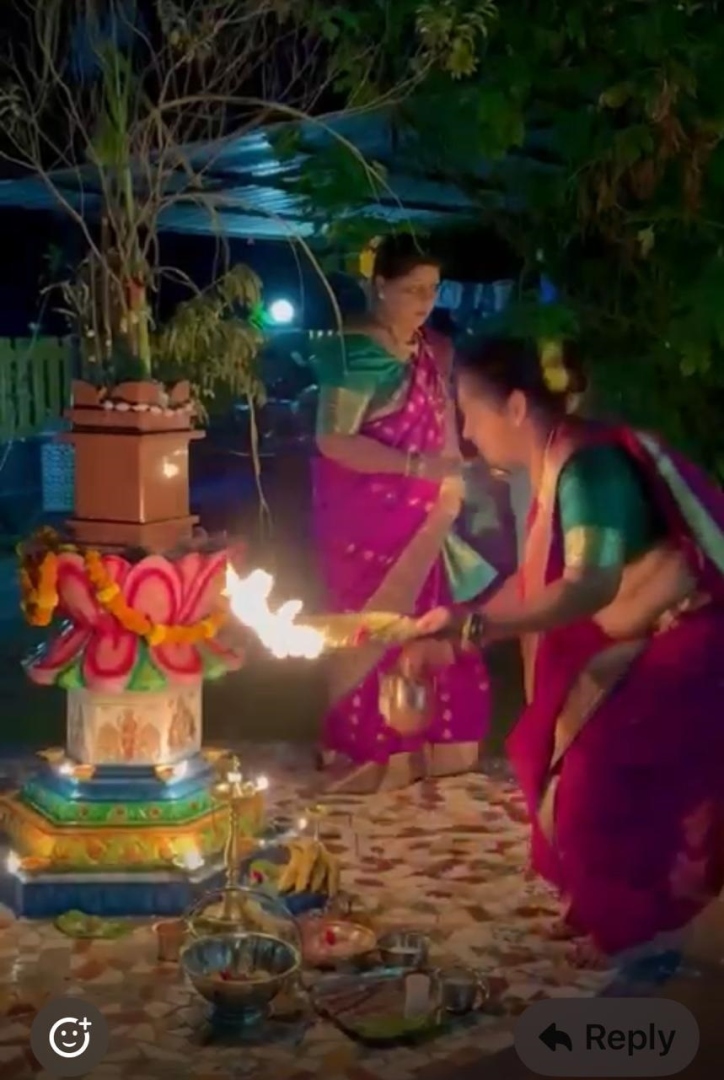
Suparna Govekar performs the Tulsi Vivah ritual at her home in Chopde, as her mother-in-law Tina Govekar looks on.
PANAJI
Tulsi Vivah (Tulshi Lagn) is celebrated across India as more than just a ritual — it is a sacred symbol of devotion, purity, and prosperity. The Dwadashi Tithi of the Shukla Paksha in the month of Kartik is considered the most auspicious day for performing Tulsi Vivah. This year, it falls on November 2.
In Goa, families usually paint their Tulsi Vrindavan a few days before the ceremony. But this year, with heavy rains continuing into the last week of October, many found it difficult to do so. Tina Govekar managed to paint hers during a short break in the rain. “I enjoy painting, and since my husband and son were busy this year, I did it myself. I even placed an umbrella over the Vrindavan to protect it from rain until the paint dried,” shares Tina, who was born into a Christian family before marrying advocate Prakash Govekar from Chopde, North Goa.
Married into the Govekar family for 33 years, Tina has devotedly followed all family traditions. Speaking to The Goan, she says, “My fasting began on Friday. The women in our family fast for almost three days, and the whole family eats only vegetarian food. Our fasting diet includes moogache kann, usal, chapatti, milk, and tea — we avoid rice during the fast. On the day of Tulsi Vivah, we prepare Prasad such as godshe, daal, ros, puri, and vegetables, which we eat after the puja. Nothing is eaten after that until the next morning.”
Tina has performed the Tulsi Vivah ritual every year since her marriage. “Last year, my elder daughter-in-law Suparna joined me. This year she’s in Oman with my son Sahil, but I’ll perform the Jodvi ritual on her behalf. In our family, offering Jodvi is a way to seek the blessings of Goddess Tulsi and Lord Vishnu,” she says.
In Chopde, the temple priest (Bhatji) visits around 12 homes to perform puja after the temple ceremony. Families usually wait between 6 and 7 pm for his arrival, and if it rains, there’s a delay. “The Bhatji has asked everyone to keep umbrellas ready just in case,” Tina adds with a smile.
In Vasco, some families perform the rituals themselves. Among them is Neeta Nanda Honavarkar, originally from Margao and born Christian (Antoinette Rodrigues). Married for 38 years, Neeta has been celebrating Tulsi Vivah since her marriage. “There are about 60 homes in our neighbourhood that observe Tulsi Vivah. Since one Bhatji can’t visit all, we’ve learnt the mantras and do the puja ourselves. My husband and son chant the mantras,” says Neeta, who continues the traditions of her late mother-in-law, Laxmi Honavarkar.
“I observe the Ekadashi fast a day before Tulsi Vivah and break it at 1 pm the next day. In the morning, we hold the Haldi ceremony, similar to what happens before a wedding. We offer the Tulsi plant a white cloth dipped in turmeric water, decorate it with marigold flowers and mango leaves, and begin the puja after 8 pm. The ritual includes holding a cloth between Tulsi and Lord Vishnu, offering floral garlands, and a mangalsutra made of mango leaves. Men light the Jodvi and hand it to the women to hold during the pheras around Tulsi,” Neeta explains.
She adds, “We also offer Haldi-kumkum to the Tulsi plant, which is dressed in red. Oti is offered to Tulsi and the women present. Prasad of Chirmulyo and sugarcane is shared among all. Around 25 people attend, and families visit each other’s homes till late evening. It’s a festival that truly brings everyone together.”
Neeta fondly remembers her mother-in-law’s stories from before Goa’s liberation, when only three homes stood in her wadda. “Now, there are many more, but every family still celebrates Tulsi Vivah and joins in each other’s rituals. That’s the beauty of it,” she says.
She also recalls attending a unique Tulsi Vivah on an island near Vasco, which took her 30 minutes by boat. “The island has both a Tulsi Vrindavan and a Cross side by side. On the morning of Tulsi Vivah, Hindus perform the ritual, while Christians hold Mass at the Cross. The Navy now controls the island, but the people continue to maintain this tradition of harmony,” she shares.
Goa continues to have people like Neeta and Tina — women who have embraced faiths beyond their own, showing deep respect and love for tradition. Through their devotion and open-mindedness, they inspire the next generation to value both faith and humanity.
Tina’s home in Chopde is surrounded by several temples and a chapel. “There’s a chapel right in front of our house, and opposite it is a Vetal temple. Around us, in clockwise direction, are the temples of Bhumika, Ravalnath, Kalika, and Chamundi, with a river flowing nearby. I feel truly blessed,” she says. Both Neeta and Tina love wearing rich zari sarees during religious festivals like Diwali and Ganesh Chaturthi.
Others, like Dr Ashmica Claire Fernandes, an occupational therapist with the NHS in London, also cherish these traditions. Married to Nitin Naik and living in Raia, she says, “As a Catholic married into a Hindu family, I’ve come to love Goan traditions like Tulsi Lagn, the ceremonial marriage of the holy Tulsi plant to Lord Vishnu. Since my mother-in-law is a widow, she marks the day by tying a sugarcane stalk to the Tulsi, lighting a lamp, and offering food in devotion. The married women in the family fast, clean, decorate the vrindavan, and perform the pooja in Nauvari sarees.”
“As a practising Catholic, I don’t take part in the ritual itself, but I help with cleaning, decorating, and preparing festive food. It’s a lovely way to share in my family’s faith and celebrate Goan culture. It reminds me that devotion and togetherness can be expressed in many ways,” says Dr Ashmica.